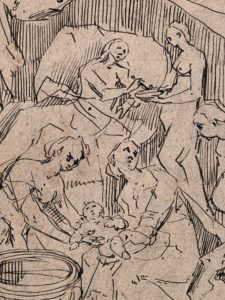 In Giving Birth in Eighteenth-Century England, Sarah Fox shrewdly and eloquently argues that in the eighteenth century ‘birthing was a process – a series of linked and flexible stages – rather than an event’ (p.7). This statement directly challenges much of the historiography that has come before it: histories of birth and birthing have traditionally been predicated upon readings of published medical texts that identified birth as a distinct moment, representing the culmination of a pregnancy. Fox calls into question the veracity of such an approach, instead offering ‘the mother’s perspective’ (p.8) of childbirth to broaden our understandings of the significance of eighteenth-century birth as a series of events with cultural, social, and personal impacts.
In Giving Birth in Eighteenth-Century England, Sarah Fox shrewdly and eloquently argues that in the eighteenth century ‘birthing was a process – a series of linked and flexible stages – rather than an event’ (p.7). This statement directly challenges much of the historiography that has come before it: histories of birth and birthing have traditionally been predicated upon readings of published medical texts that identified birth as a distinct moment, representing the culmination of a pregnancy. Fox calls into question the veracity of such an approach, instead offering ‘the mother’s perspective’ (p.8) of childbirth to broaden our understandings of the significance of eighteenth-century birth as a series of events with cultural, social, and personal impacts.
Fox begins her monograph by quoting Betsy Ramsden, whose 1767 pregnancy was ‘lively and sociable’ (p.7) – much like Fox’s representation of the various stages of birth. By beginning with this excerpt, Fox immediately establishes the centrality of women’s narratives to her work. Readers are further encouraged to immerse themselves in the material and sensory elements of eighteenth-century childbirth through Fox’s organisation of birthing experiences into thematic chapters. Focusing on birth and its relation to the body, the household, food, family, and community, each chapter illustrates the multiple relationships that defined eighteenth-century experiences of birthing, beyond the solely medical.
Offering a glimpse into the tangible experiences of birthing, Fox approaches the birthing body and its sensations through the clothing that supported it, the food that nourished it, and the individuals that aided it. I found Fox’s comments on the mutability of the pregnant body, and how this translated into the transience of the material conditions of birth, particularly illuminating. Discussing the cyclical nature of female clothing in the period, Fox comments that ‘the embodied experiences of pregnancy and birth were subsumed into the wearer’s everyday identity’ (p.50). Maternity was therefore embodied during, and beyond, gestation and parturition through the mother’s recycled clothing. The emblematic nature of food, and its significant to birthing rituals, is further evidence of the ways in which quotidian materiality permeated the birthing chamber more so than medical implements.
The self-defined eclecticism of Fox’s innovative and expansive use of source material is its strongest point. Drawing on correspondence, folklore, manuscript recipe books, published medical texts, and Northern Assize Court records, Giving Birth weaves together a breadth of source material impressive in its scope and originality. Fox is conscientious of the ‘methodological difficulties’ (p.69) that some of her source types can raise, yet successfully validates the unique insight that each lends to her argument.
Fox’s monograph is a crucial intervention in the history of birth. Her work reinvigorates the field and encourages future scholars (myself included) to explore beyond the histories of medicine and midwifery that have previously framed academic inquiries into experiences of birth and gestation in the early modern period. Instead, Fox offers a timely riposte to typical approaches to histories of birthing, presenting mothers’ experiences of childbirth front and centre.
Amber Vella is a Midlands4Cities-funded PhD researcher based at the University of Leicester. Her research explores narratives of pregnancy in late Georgian Britain.
